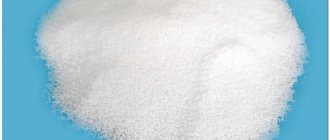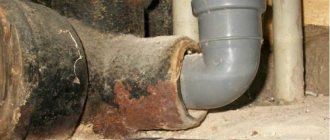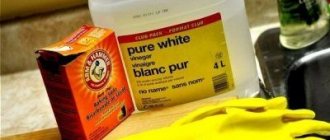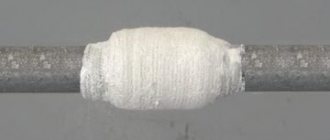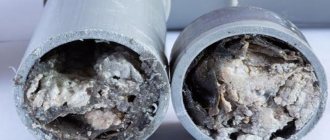Home / Stains
Back
Published: 04/09/2020
Reading time: 14 min
0
10
- 1 Safety rules
- 2 Basic properties and composition of soda
- 3 Safety rules 3.1 Cleaning pipes
- 7.1 Solution
Safety regulations
When using sodium hydroxide:
- You must wear a mask and gloves.
- You cannot deviate from the proportions (except for soap making).
- Caustic must be stored in a jar with a tight-fitting lid, away from children and animals.
According to the European classification, caustic soda is included in the second group in terms of danger level and is characterized as a caustic or corrosive substance.
https://www.youtube.com/watch?v=u2Un0-NrFdQ
She is capable of:
- cause severe chemical burns;
- cause irritation of the cornea or skin;
- injure the respiratory tract;
- cause metal corrosion.
Important. If timely assistance is not provided, contact of caustic alkali on mucous membranes or skin can cause irreversible consequences, such as blindness.
To avoid the negative effects of a substance on the body, you need to protect yourself.
The chemical causes severe burns, so it should be kept out of the reach of children and pets. Caustic sodium is stored in a tightly sealed, labeled container away from heating elements and open flames, since caustic sodium is explosive and flammable.
In powder and solution form, caustic soda is stored for 1 year from the date of production.
Limescale and urinary stone in the toilet: how to remove it and how to clean it at home?
Sodium hydroxide is a powerful alkali that can corrode even hard materials. To preserve your health and the integrity of surfaces, it is imperative to take precautions.
- Wear protective equipment. Before starting the procedures, arm yourself with goggles and a mask, rubber gloves should reach your elbows, clothing should be tight and not leave exposed areas of the body. This will protect yourself from chemical burns.
- Wait for the reaction to complete. Since caustic, when interacting with water, is capable of generating heat, you should not immediately start performing procedures with it. Wait a few minutes for the chemical reactions to complete.
- Do not spray the product. Surfaces, especially enameled ones, may suffer from this.
- Avoid contact with skin. If the product gets on exposed areas of the body or in the eyes, rinse them immediately under running water. Then treat with 2% boric acid. If after half an hour the burning sensation and redness still do not go away, seek medical help.
- Store correctly. Caustic must be stored in a well-closed iron or glass jar. It should not be in the public domain, as it is poisonous and explosive.
Remember that frequent use of caustic can lead to the destruction of the surface of even the most durable materials.
Benefits of using caustic soda
Despite its high chemical activity, caustic soda is included in almost all products recommended for cleaning drains. For household needs, it is available in the form of gels, powder or granules. The method of cleaning sewers using sodium hydroxide is convenient because:
- the reagent copes well with various types of contaminants in the sewer;
- alkali has a corrosive effect on fatty deposits and other organic compounds accumulating in sewage drains;
- neutralization with alkali is necessary after cleaning the sewer with acid, which has a corrosive effect on the pipes;
- caustic soda also destroys solid contaminants in the sewer, softening and decomposing them, after which they are easily washed out of the pipeline;
- The advantages of the application also include the availability of the product and ease of use.
Some disadvantages of this method are associated with the chemical activity of caustic soda:
- when cleaning bathtubs or sinks, an aggressive alkaline environment destroys the enamel over time;
- When working, protective equipment is required.
Basic properties and composition of soda
Caustic soda is a common and strongest alkali. It has the appearance of scaly white granules without a pronounced odor. The size of the scales ranges from 0.2 to 0.5 mm. The substance has excellent hygroscopic properties and is also remarkably soluble in water. When dissolved, it releases heat.
Caustic soda is also known as technical caustic soda and caustic soda. It is produced in liquid and solid form. The substance is intended for the chemical, metallurgical, automotive, food (E 524), light, gas and oil industries. Caustic has taken its rightful place in medicine. This soda is used for the production of mineral fertilizer, biofuel and in the pulp and paper industry.
Although the substance is used in many fields of activity, it has some unpleasant features. The disadvantages of caustic soda include:
- the substance is unsafe; when working with it you need to use gloves and goggles;
- you need to be careful, as the substance slowly corrodes the enamel coating of the bathtub and sink.
However, soda has many positive aspects, which include:
- the product 100% corrodes all fatty and organic deposits;
- works even after flushing the sewer;
- smoothes out roughness inside the pipes, which slows down the deposition process;
- For prevention, it is enough to use once a month;
- soda has a low price and is available in all stores.
The substance has strong destructive abilities and can corrode aluminum and zinc surfaces. Soda is used for industrial disinfection. Caustic sodium is explosive and is classified as a highly hazardous flammable substance. Caustic soda has the following formula: NaOH.
- the substance must be stored in a tightly closed container and out of the reach of children;
- when using soda, you need to use safety equipment such as gloves, goggles, a mask and a gown;
- upon completion of work, you must carefully clean the surface and wash your hands;
- if the substance gets on the mucous membrane, then you need to wash the affected area with water and wipe with a 2% boric acid solution, and then you should definitely consult a doctor;
- If the solution gets on the skin, the affected area must be wiped with vinegar essence.
All unsafe products require careful handling, this also applies to caustic soda. When purchasing such a substance, it is important not only to study the recommendations for use, but also to carefully follow them. Then such a dangerous substance as caustic soda will help restore order in the house and will not harm your health.
Caustic soda is an alkali without a particularly strong odor, having the appearance of white scaly granules. It easily dissolves in water and accordingly has excellent hygroscopic properties. But housewives should remember that when it comes into contact with water, soda generates heat.
Caustic soda is known to many from chemistry courses as sodium hydroxide. It can be either liquid or solid. It is widespread in the production of fertilizers, biofuels, as well as in pulp and paper mills.
But there are a number of limitations when using caustic soda at home. Thus, goggles and gloves are required when working with the substance, due to its toxicity. In addition, soda requires mandatory and thorough rinsing with water if used to clean sinks and bathtubs. It slowly but surely eats away the enamel.
Caustic also has a number of positive aspects:
- The product instantly and completely dissolves fat of any age;
- Removes all deposits in sewer pipes. But you should remember to thoroughly rinse;
- Low price and availability in all hardware stores.
We invite you to familiarize yourself with Baking soda formula properties
Caustic dissolves in water, releasing a large amount of heat. Thanks to this, it is used literally everywhere. its advantages:
- Corrosion of fats and other organic deposits.
- Destroying bacteria.
- Affordable price.
Flaws:
- Caustic (if it gets on the skin or mucous membranes it causes a chemical burn)
- Susceptibility to fire.
- Explosion hazard.
It also has the following properties::
- Soluble in ethanol, methanol and glycerin.
- Insoluble in acetone.
- Reacts actively when interacting with aluminum, lead, zinc and tin.
- Flammable when interacting with ammonia.
- When melted, it destroys the structure of glass and porcelain.
Caustic soda is a hygroscopic large toxic powder that quickly melts in air. It belongs to the strong bases and is volatile in liquid form.
Sodium hydroxide is completely soluble in alcohols, but not in acetone. Caustic soda does not react chemically with chromium-nickel and carbon alloys and artificial polymers.
Alkali destroys leather, paper and fabrics. The substance interacts with aluminum, zinc, tin, magnesium, and as a result of contact with them, hydrogen is formed, which can cause an explosion.
General characteristics
The chemical formula of caustic soda, NaOH, which is common in everyday life, indicates that it belongs to a variety of powerful alkalis. Known by several other names. Caustic is more commonly used, caustic soda is found, and the name sodium hydroxide is less commonly used.
It is a solid white substance. In powder form, it looks like scaly miniature granules. They are practically devoid of a specific smell.
Caustic is hygroscopic. Easily dissolves in water. Directly in this case, a reaction occurs with the release of a significant amount of heat. The resulting solution is soapy to the touch.
Expert opinion
We recommend!
Produced in powder and liquid form. Sodium hydroxide, in addition to industrial applications, is widely used to solve some household problems. Along with the effectiveness of the product, the affordable price attracts.
Safety regulations
- When working with caustic soda, it is recommended to wear safety glasses, rubber gloves and clothing that protects against exposure to chemicals (vinyl-impregnated or rubberized suits).
- The concentration of caustic alkali in the air should not exceed 0.5 mg/m³.
- To protect the respiratory tract, you should use a respirator or a cotton-gauze bandage.
- If sodium hydroxide gets on your skin, hair or mucous membranes, you must provide first aid and consult a doctor.
Despite the second class of danger, caustic soda can be used on the farm (subject to appropriate safety measures).
Pipe cleaning
Using caustic soda to clean drains gives very good results. The alkali will help not only deal with the blockage, but also remove unpleasant odors in the toilet and bathroom. Application methods are as follows:
- Pour half a glass of caustic into the drain hole, carefully pour a glass of boiling water on top and leave for at least two hours. After the specified time, rinse the drains with plenty of water.
- Pour two hundred grams of soda into the hole, add the same amount of white vinegar, leave for three hours, rinse thoroughly with boiling water. This flushing method is used for severe, old clogs.
- Pour two kilograms of caustic into a bucket of boiling water, mix, pour sodium hydroxide and water directly into the drain hole. After three hours, clean the pipes with water.
Important: do not pour soda directly onto the enamel surface of the bathtub, as this may damage the enamel.
Soda can be used when washing; it softens water well and removes various stains. Use caustic soda solution only for washing linen and cotton items; washing silk, wool and other fabrics that require careful handling is not recommended. To prepare the solution in a five-liter container, you need to dilute five tablespoons of soda and mix.
Important: after using caustic soda, things must be rinsed thoroughly.
Carbon deposits and old fat can be removed from steel and cast iron cookware using alkali. You will need the following ingredients:
- Soda - 200 g.
- Water - 10 liters.
- Silicate glue or liquid glass - 150 ml.
- Laundry soap - one bar.
Preparation of the solution: pour water into a container, add soda, glue or liquid glass, grated washing soap, mix everything thoroughly. The dishes are dipped into the washing solution, the container is placed on the fire and boiled over low heat for two hours, after which you need to wait until it cools completely. Rinse the cleaned dishes well under running water.
Important: aluminum and Teflon cannot be washed with caustic soda; calcined salt is used for such dishes. The difference between them is that calcined salt is much less active and will not damage the dishes.
Industrial Applications
The chemical is widely used in industry:
- sodium hydroxide is added to creams, cleaning products, powders, soaps, shampoos, and clog removers,
- it is used for the production of fibreboards, cardboard and paper,
- sodium hydroxide - emulsifier E 524, which allows you to achieve a crispy crust, it is used for the production of chocolate and ice cream,
- the chemical is used for etching aluminum as an indicator for titration,
- caustic soda is used for bleaching fabrics, including linen, making silk,
- Caustic solutions are used in the food industry as a cleaning agent for washing greasy surfaces, peeling fruits,
- sodium hydroxide is used to disinfect ponds and livestock farms; in agriculture it is used as a fertilizer and to control pests that cause plant diseases,
- In caustic construction it is used to strengthen the foundation.
In addition, sodium hydroxide is used to purify oil and water, and to produce chloramine and biodiesel.
There is caustic soda in the photograph developer.
Caustic soda has found wide application in industry:
- Food. Known as additive E-524. Used for making chocolate, ice cream, drinks. In addition, it can be used to clean equipment.
- Textile. For silk production and bleaching.
- Pulp and paper. For the production of paper and cardboard.
- Chemical. For the production of detergents.
- Automotive. For the production of batteries (alkaline) and biodiesel.
Figure 2 - industrial packaging of caustic soda.
How to treat a burn
If sodium hydroxide comes into contact with the skin, rinse it under the tap; you can treat the affected area with 1% acetic acid or diluted citric acid. Do not wipe the burn area with a damp cloth.
If caustic soda gets on the mucous membranes, it can be washed off with water or neutralized with a weak solution of boric acid. If the redness and burning do not go away, you should consult a doctor.
We suggest you read How to clean a carpet with soda at home, reviews
The unexpected can happen to even the most careful person. For sodium hydroxide burns:
- if caustic gets on the mucous membrane: rinse with a 2% solution of boric acid, then with plenty of running water; consult a doctor as soon as possible;
- if caustic gets on the skin: do the same as for a burn of the mucous membrane, but treat the affected area with a 5% vinegar solution (for 1 tablespoon of 70% vinegar 13 tablespoons of water).
Attention! If caustic soda gets into your eyes, rinse them with cool water for several minutes.
First aid for damaged skin includes several points:
- Washing off the alkali. The procedure must be carried out for at least 20 minutes. Only water can be used for cleaning. Wet wipes or a dampened towel are not suitable, as they may cause the reagent to penetrate deeper into the skin structure.
- Neutralization of alkali action. At this stage, the damaged area is treated with an aqueous solution of vinegar or lemon juice.
- Relieving pain. To implement this point, apply a bandage soaked in cold water to the burn site or take painkillers.
Attention! If the damaged skin becomes blistered, you should immediately call an ambulance.
Precautionary measures
- Caustic soda is a potent substance; in terms of its danger to humans, GOST classifies it as the second hazard class.
- The crystal powder should not be taken by hand; it should either be carefully poured out of the bag or a spoon should be used.
- Contact with skin results in burns. In this case, wash the affected area of skin with water, weakly concentrated solutions of boric or acetic acid.
- The greatest danger is if the solution gets into the eyes, resulting in loss of vision. Measures are taken immediately: the eyes are also washed, first with the above solutions, then with water.
- Therefore, it is better to protect yourself from direct contact with caustic sodium using personal protective equipment: rubber gloves, special goggles for eye protection, and overalls.
Scope of application of sodium hydroxide
Despite the fact that caustic soda, soda ash and baking soda belong to the same group of sodium compounds, there are still differences.
- According to the chemical formula. For calcined it is Na2CO3, and for food it is NaHCO3.
- By force of influence. The softest is baking soda, the second place is occupied by soda ash, and the undisputed leader is caustic soda. Caustic is able to cope with the most severe dirt and blockages. Calcined and food-grade ones cannot do this.
- For safety. Caustic soda is much more aggressive than all its “relatives” and has a higher hazard class, so precautions must be taken when working with it.
Caustic soda has a relatively shorter shelf life - no more than 12 months from the date of release, see instructions. Afterwards it loses its characteristic properties. In this case, caustic soda should be stored in well-closed containers, in dark and cool places.
On an industrial scale, caustic alkali is used for:
- determining the acid concentration or neutralizing its effect;
- aluminum processing;
- regulation of acid levels in food;
- wastewater treatment from heavy metals;
- normalization of water pH;
- manufacturing of medicines;
- giving cotton fabrics a silky shine;
- production of cosmetics.
At home, caustic soda is used mainly for cleaning sewers and cesspools.
What is
Caustic soda, as caustic soda is also called, is widely known throughout the world as an alkali that can corrode organic matter.
Of all three types of soda - baking soda, soda ash and caustic soda, the latter has the greatest cleaning power. Outwardly it looks like a powder consisting of light crystals or flakes, odorless, ranging in size from 1.5 to 2 cm (pictured).
Fighting blockages in sewer pipes
Where is this rubber soda used and how to dilute it at home? Before starting work, you need to make sure that contact with caustic occurs without consequences. Rubber gloves, goggles, and a protective mask are mandatory attributes. Sodium hydroxide has the ability to immediately dissolve fat, no matter how old it is.
If you live in a private house, then to remove blockages you need 3 kg of caustic powder, and in an apartment building 2 kg is enough. You will also need a plastic bucket with thick walls with a volume of 10-12 liters and a convenient scoop or scoop.
The process of preparing the solution itself is as follows. Pour the required amount of alkali into the bucket. Carefully fill with cold water, but not to the very top, but a little more than half (6-7 l), mix well. As soon as the chemical reaction ends, the composition is ready.
We use only cold water for the solution. Caustic, when dissolved, releases heat. Therefore, hot liquid may boil and splash. Cool temperatures will reach a maximum of 70oC.
Solution
Peculiarities. Cast iron and steel can withstand this processing method, but not plastic pipes - caustic can simply corrode the surface of the material. If the blockage is small, it is enough to carry out the procedure once. In advanced cases, manipulations must be repeated after two weeks.
Your actions
- Carefully pour approximately half of the total weight of the resulting caustic solution into the drain hole.
- Make sure that the product does not splash onto the surface of the floor or sink - caustic can corrode the enamel.
- Wait about two to three hours (do not use plumbing).
- Pour in the rest of the solution and wait the same amount of time.
- Turn on the water and pour it into the drain for 10-15 minutes at maximum power.
- If you live in an ordinary high-rise apartment, then the solution does not need to be divided into two doses - fill it all at once. The rest of the manipulations are the same.
"Dry" method
Peculiarities. The method is one of the most effective, but requires maximum care. Suitable for prevention and disinfection, as well as after treatment of sewerage with acidic agents - this way you can neutralize the aggressive effects of acid. Keep in mind that the “dry” cleaning method may damage the pipes.
Your actions
- Pour 2-3 liters of hot water into the drain. This is done to warm the pipes and increase the effectiveness of the procedure.
- Pour two or three tablespoons of powdered or granulated caustic soda (in advanced cases, you can even take one glass) down the drain. Make sure that the substance does not spill onto the surface of sinks, toilets and bathtubs.
- Then pour in hot water (only 200-250 ml is enough).
- Wait two to three hours for the chemical reactions to take place completely.
- Turn the faucet on full blast and rinse off the solution.
Peculiarities. Liquid caustic is less effective in combating blockages, but is safer and more convenient to use. Ideal for preventive purposes. It is enough to repeat cleaning once or twice a month.
Your actions
- Shake the gel thoroughly without opening it.
- Pour about a glass or a little more into the drain (take care of enamel surfaces).
- Follow this with a glass of hot water and wait two to three hours.
- Open the tap to maximum pressure, pour into the drain for 10-15 minutes. This time will be enough for the softened dirt residues to be washed away.
Using caustic soda, you can clean the drains in the bathroom or toilet yourself.
Advice. Caustic soda should not be used for kitchen pipes, since, by reacting with fatty substances accumulated there, it can cause the blockage to thicken.
For cleaning, use sodium hydroxide solution or powder. The second option is safer to use. The powder is poured into the sewer hole, observing all precautions, a glass of warm water is poured into it and left for 2-3 hours. After this time, the pipe is washed.
Another application is to neutralize the effects of acidic agents.
Acids effectively remove any type of grease deposits, which is why they are often used to clean sewer pipes. However, over time they provoke the appearance of metal corrosion. Treatment with caustic soda helps stop this process.
We suggest you familiarize yourself with Lightening jeans with soda
Where to buy and how much it costs
You can buy the chemical at a hardware store or hypermarket, in the department that sells household chemicals. Its price may vary depending on the manufacturer and weight. At retail, 250 g of caustic soda costs around 200 rubles.
Caustic soda can be purchased at hardware stores. Sometimes it is found in departments specializing in the sale of goods for soap makers. It can also be found on the Internet: on sites specializing in the supply of caustic soda. The price per kilogram usually does not exceed 100 rubles.
Sodium hydroxide is often included in multi-component products designed to clean dishes, cesspools and sewer pipes. You can find them in departments offering household chemicals. Such products are intended for home use and are therefore relatively safe. In addition, their effectiveness is higher than that of conventional caustic alkali due to the inclusion of additional ingredients.
Caustic soda can cope with complex stains on dishes and facilitate the process of cleaning sewers and waste pits, but it can only be used if precautions are carefully observed.
If this substance gets on the mucous membranes or skin in the absence of timely help, it can have irreversible consequences. Therefore, for home use it is better to choose safer options.
Caustic soda is a widely used product, so you can buy caustic soda in various specialized stores:
- in hardware stores - detergent departments;
- gardening stores;
- construction markets;
- soap shops.
The product is also sold on online platforms. Approximate cost up to 100 rubles. per kilogram.
When using caustic alkali in everyday life, take precautions, then soda will turn from a dangerous substance into an effective assistant for cleaning and disinfecting your home and garden.
Sodium hydroxide is available at building supply and plumbing supply stores.
Reviews
On the Internet on forums, caustic soda receives mostly positive reviews, various cleaning recipes are offered, and there are many videos about the use of the substance. One of them is offered to your attention.
At the same time, forum members emphasize that caustic soda is not a panacea for all blockages in sewer systems. Complex, stagnant blockages can only be cleared mechanically: with a cable or by dismantling a plastic pipe, where possible, followed by cleaning.
Cleaning the cesspool
Peculiarities. Getting caustic into the soil has a negative effect on the soil. Therefore, the pit must be absolutely sealed and have a proper ventilation system.
Your actions
- Prepare the solution according to the same principle as described above for sewer pipes. Depending on the size of the pit, 2-4 kg of caustic soda will be required.
- Fill the drainage hole with the mixture.
- As a rule, the active period of the product lasts about four minutes.
- The cycle must be repeated twice.
Caustic soda is classified as a gentle substance for cleaning cesspools, but its use is possible only if all conditions are met:
- Septic tanks must be sealed, since the substance, when reacting, can harm the soil and the environment.
- To avoid an explosive situation, the ventilation system must operate without interruption.
- You cannot start cleaning without a protective suit, gloves, and goggles.
Sewage pits are cleaned using a caustic alkali solution.
The portion of soda indicated in the instructions is diluted in cold water, stirring constantly. At the peak of its activity, the composition lasts for about four minutes, so the product is immediately used for its intended purpose.
Soot and scale
You can often see sodium hydroxide recommended as an effective home remedy for cleaning dishes from scale and deposits.
Caustic soda can really cope with these problems due to its ability to easily remove even old plaque.
Approximately half a glass of caustic alkali is diluted in a bowl of cold water, the dishes are immersed there and left for 5-15 minutes, depending on the degree of contamination. If necessary, repeat the procedure.
Modern cleaning products cope with soot and scale no worse than caustic sodium, but do not require careful adherence to personal safety rules.
Therefore, it is advisable to use caustic soda only when other methods have proven ineffective.
